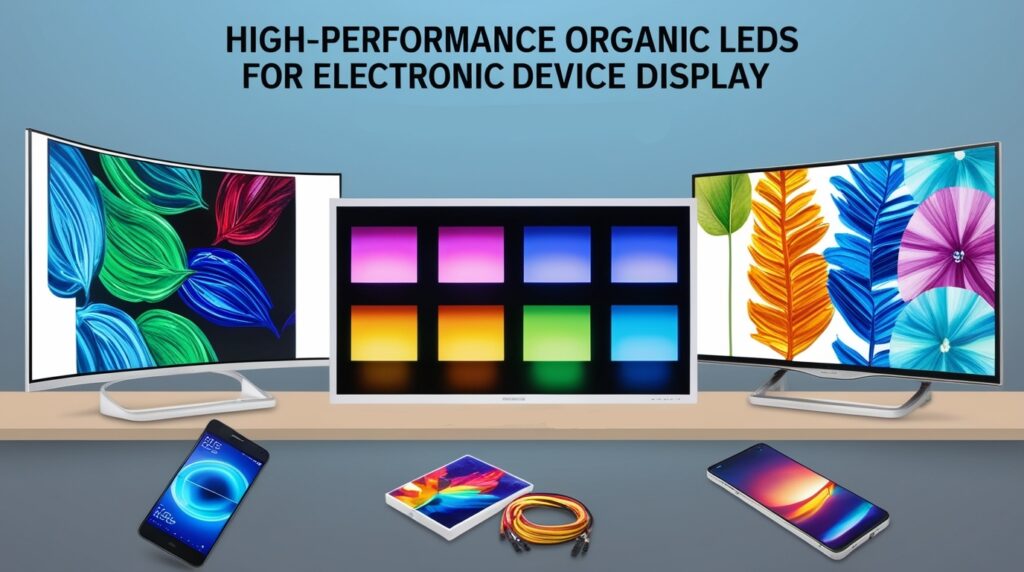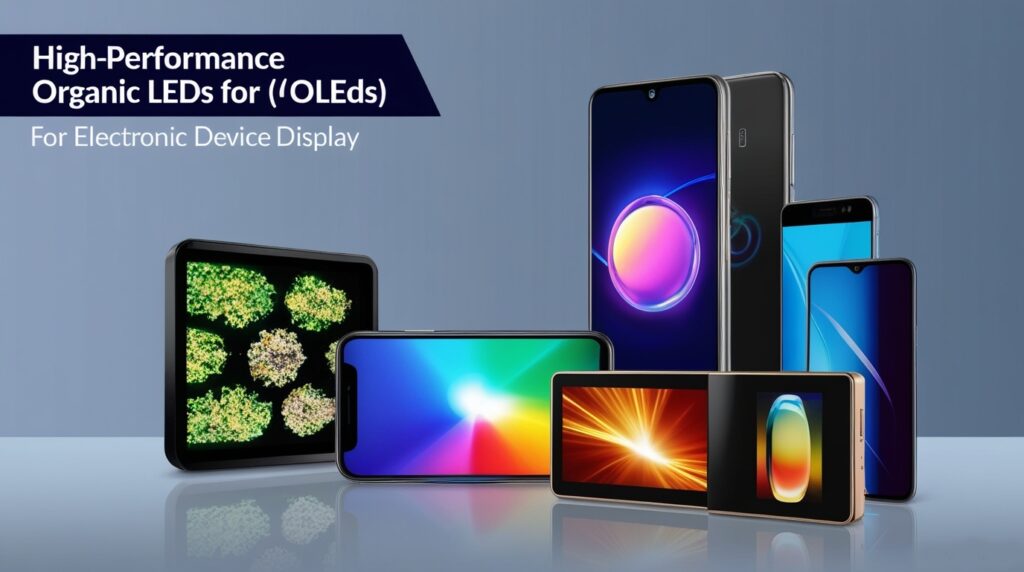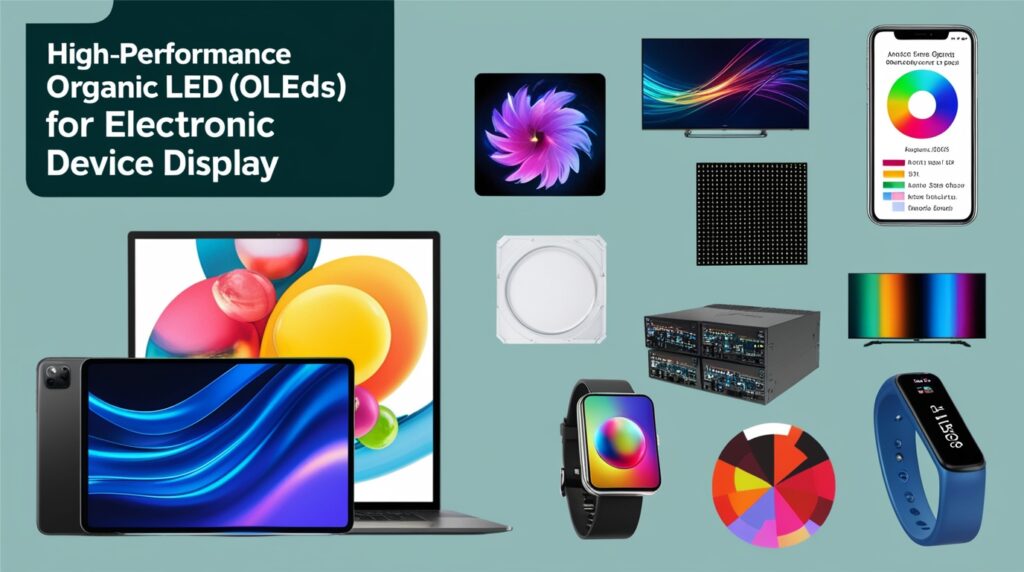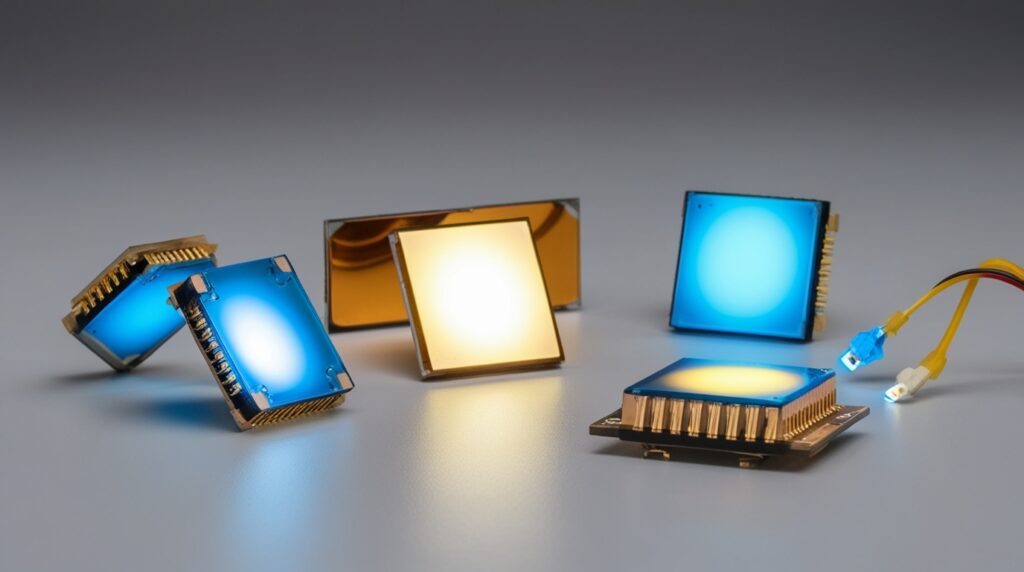
Introduction
High-performance organic LEDs (light-emitting diodes) (OLEDs) are advanced display technologies that utilize organic materials to emit light when an electric current is applied. Since their inception in the 1960s, OLEDs have gained prominence for their energy efficiency, flexibility, and superior image quality, making them a leading choice for various electronic device displays, including smartphones, televisions, and wearables. Their ability to produce true blacks and a wider color gamut has revolutionized visual technology, driving demand in both consumer and industrial markets.
Notable advancements in OLED technology began in the late 1980s when researchers developed layered structures that significantly improved efficiency and performance. This innovation catalyzed extensive research and investment in OLEDs, leading to their integration in high-end devices and expanding applications across multiple sectors. The OLED market is projected to experience rapid growth, with an estimated valuation of USD 367.22 billion by 2032, driven by technological innovations and increasing consumer demand for eco-friendly, high-quality displays.
Despite their advantages, OLEDs face challenges such as high production costs, limited lifespan compared to traditional displays, and sensitivity to environmental conditions. These issues have sparked ongoing research aimed at enhancing material durability, optimizing manufacturing processes, and reducing costs to ensure broader adoption. As the industry continues to evolve, the integration of artificial intelligence and innovative fabrication methods holds promise for overcoming existing limitations and expanding the capabilities of OLED technology.
History
The development of high-performance organic light-emitting diodes (OLEDs) has evolved significantly since the early discoveries in organic materials. The initial forays into organic electroluminescence can be traced back to the 1960s, where foundational research led to the patenting of organic electroluminescent phosphors by Gurnee and Fernandez in 1965. Despite this early work, practical applications remained limited until advancements in the 1980s. In 1987, Tang and VanSlyke demonstrated a working OLED using a layered structure of organic compounds, which established the groundwork for modern OLED technology. Their device exhibited notable efficiency and paved the way for further exploration into the properties and applications of organic materials in displays.
This breakthrough prompted a surge in research during the 1990s, where new conjugated polymers and small-molecule materials improved the efficiency of OLEDs significantly, reaching efficiencies of up to 4%. As the 21st century approached, developments in fabrication techniques, particularly solution processing, allowed for more cost-effective production methods. Research into the layering of materials in OLEDs contributed to further efficiency gains, and by the early 2000s, devices were achieving efficiencies nearing 18%. This trajectory of innovation has continued, with extensive research conducted by various academic and industrial institutions leading to enhanced performance and broader application of OLED technology in consumer electronics.

Structure and Composition
The basic structure of organic light-emitting diodes (OLEDs) typically consists of multiple layers, each serving a specific function to enhance device performance. An OLED generally includes an anode, a hole injection layer (HIL), a hole transport layer (HTL), a light-emitting layer (LEL), an electron transport layer (ETL), an electron injection layer (EIL), and a cathode. Electrons and holes are injected into the LEL from the electrodes, where they recombine on emitter molecules to produce light, with the color of emission dictated by the specific emitter used.
Organic Semiconductor Materials
The active layers in OLEDs utilize organic semiconducting materials, which have gained attention due to their diverse chemical structures and the advantages they present, such as mechanical flexibility and tunable optical properties. These materials can be classified into p-type and n-type semiconductors. Recent advancements have been made in n-type organic small molecules that exhibit high electron mobility, making them critical components in constructing complementary logic circuits and p-n heterojunctions.
Electrode Materials
Conductive materials are essential for the electrodes in OLEDs. Conducting polymers like PEDOT:PSS have been widely adopted due to their superior mechanical flexibility compared to traditional inorganic electrodes. The conductivity of these polymers can be optimized through various methods, such as removing insulating components to enhance the formation of conducting domains.
Integration and Optimization
The design and optimization of the multilayered device architecture play a pivotal role in achieving high efficiency and stability in OLEDs. Strategies have been developed to enhance charge transport, facilitate charge injection, and promote radiative recombination within the layers. Continuous research is focused on improving the properties of these materials and exploring new compositions to further enhance the performance and cost-effectiveness of OLEDs. This innovative approach to material design not only enhances the functionality of OLEDs but also facilitates the development of flexible and foldable electronic devices, broadening the scope of their applications in modern electronics.
Mechanism of Operation
The operation of high-performance organic light-emitting diodes (OLEDs) involves several critical processes that ensure efficient light emission and device performance.
Light Emission
The light emission in OLEDs occurs primarily in the emissive layer, where excitons are formed due to the recombination of injected electrons and holes. The energy released during this process is emitted as photons, resulting in visible light output. The efficiency of this process can be influenced by the design of the OLED materials and the architecture of the device. For instance, employing color filters in the design allows for purer wavelengths of light and improved contrast ratios on display panels without sacrificing light intensity.
Charge Injection and Recombination
When a voltage is applied across an OLED, the anode becomes positive in relation to the cathode, allowing electrons to flow through the device. Electrons are injected into the lowest unoccupied molecular orbital (LUMO) of the organic layer at the cathode, while holes are injected into the highest occupied molecular orbital (HOMO) at the anode. The movement of these charge carriers leads to their recombination, resulting in the formation of excitons, which are bound states of an electron and a hole.
Charge Transport Layers
To achieve high internal efficiency, it is crucial to maintain a balanced charge injection and transfer. The thickness of the charge transport layers can be optimized, but this method is often challenging to control. An alternative approach involves utilizing exciplexes, which are formed at the interface between hole-transporting (p-type) and electron-transporting (n-type) materials. This configuration localizes electron-hole pairs and transfers energy to the luminophore, thereby enhancing both efficiency and color purity in OLEDs.
Advanced Material Technologies
The choice of organic materials plays a significant role in determining the performance of OLEDs. Recent advancements include the development of new molecular structures that feature an electron-conducting core surrounded by insulating components, akin to a coaxial cable. This design helps mitigate charge trapping, thereby improving overall device efficiency. Additionally, the implementation of physiological-friendly light sources, such as OLEDs that mimic the emission spectrum of candlelight, demonstrates the potential for high-quality illumination in future applications. By optimizing these mechanisms, OLED technology can achieve high external quantum efficiency and color purity, making it a compelling choice for electronic device displays.

Advantages
Organic Light-Emitting Diodes (OLEDs) possess several notable advantages that enhance their appeal for use in electronic device displays.
Energy Efficiency
OLEDs exhibit higher energy efficiency compared to traditional display technologies. Each pixel in an OLED display generates its own light, eliminating the need for a backlight. This means that power is consumed only by the lit pixels, allowing dark or black pixels to use no energy at all. As a result, OLEDs not only contribute to reduced energy consumption but also promote longer battery life in portable devices.
Flexibility and Design Versatility
One of the standout features of OLED technology is its inherent flexibility, allowing for the creation of curved, bendable, and even rollable displays. This flexibility is particularly beneficial in the growing fields of wearable technology and innovative gadget design, enabling manufacturers to produce devices that are not only functional but also visually appealing. For instance, LG has showcased thin displays that are less than 4 mm thick and have demonstrated prototypes that can be transparent or disappear when turned off.
Superior Image Quality
OLED displays are renowned for their superior image quality. They can produce true blacks and a wider color gamut, resulting in a more vibrant and lifelike viewing experience. This attribute is especially advantageous for users engaged in visual content consumption or graphic-intensive gaming. The fast response times of OLEDs contribute to smooth, blur-free motion, enhancing the overall user experience, particularly during fast-paced action sequences.
Thinness and Lightweight Design
The absence of a backlight enables OLEDs to be exceptionally thin, which allows for sleeker device designs and lighter gadgets. This attribute is especially crucial for mobile devices, where weight and thickness are significant considerations for user convenience.
Market Growth and Demand
The flexible OLED segment is anticipated to witness rapid growth, with a projected Compound Annual Growth Rate (CAGR) of 19.9% from 2024 to 2030. This growth is driven by innovations that enhance user experience and device functionality, including the development of foldable smartphones and curved monitors. As demand for these versatile displays increases across various applications, such as automotive and consumer electronics, so does the investment in their manufacturing, leading to reduced costs and improved yield rates. These advantages collectively position OLED technology as a leading choice for high-performance displays in electronic devices, contributing to its widespread adoption in the market.
Applications
High-performance organic LEDs (OLEDs) are increasingly prevalent in various electronic device displays due to their superior qualities such as vibrant colors, deep blacks, and energy efficiency. Their applications span several key sectors, including smartphones, tablets, smartwatches, televisions, and digital signage systems.
Consumer Electronics
OLED technology has become a staple in consumer electronics, particularly in smartphones and tablets, which dominated the market with a revenue share of 24.8% in 2023. The demand for high-resolution screens and immersive viewing experiences has led manufacturers like Samsung and Apple to adopt OLED displays in their flagship models. For example, the Samsung Galaxy S23 FE features a 6.3-inch OLED display, showcasing the technology’s rapid integration into popular devices.
Televisions
In the television sector, companies such as LG Electronics have positioned themselves as market leaders with premium OLED TV

Challenges and Limitations
Despite the promising advancements in high-performance organic light-emitting diodes (OLEDs), several challenges and limitations continue to impede their widespread adoption in electronic device displays.
Production Costs
One of the primary hurdles in scaling OLED production is the high cost of advanced materials, such as indium tin oxide (ITO), which are both expensive and rare. This scarcity drives up production costs, making it difficult for OLED displays to compete with more established technologies. Reducing manufacturing costs through alternative materials and roll-to-roll fabrication techniques remains an area of active research and development.
Efficiency and Lifespan
OLED technology is still characterized by certain inefficiencies. The typical lifespan of OLED displays is generally shorter compared to their LED counterparts due to the organic materials used, which degrade over time. While advancements have been made, achieving longevity comparable to that of LEDs remains a challenge. Limited efficiency and performance degradation over time can also affect the overall user experience.
Manufacturing Defects
Achieving high yields in OLED production presents another significant challenge. The manufacturing process requires a high level of precision; even minor defects can result in substantial waste, rendering large sections of substrates unusable. Therefore, manufacturers are focused on improving process control and reducing “killer defects” to enhance yield rates, especially as display resolutions increase.
Market Competition
Affordability continues to be a critical barrier for OLEDs to dominate the display market. While OLEDs are already utilized in various consumer electronics, they must significantly reduce manufacturing costs to compete effectively with established technologies like LCDs, especially in price-sensitive segments.
Performance Under Varying Conditions
The sensitivity of OLEDs to temperature fluctuations can also limit their practical applications. The technology’s performance may vary under different environmental conditions, which can lead to durability issues and instability over time. This limitation presents a challenge for manufacturers aiming to produce OLEDs for a wider range of uses.
Recent Technological Advancements
Innovations in OLED Technology
OLED technology is advancing rapidly, driven by innovations in material engineering, fabrication methods, and the integration of artificial intelligence (AI) in production processes. These developments promise to enhance the brightness, efficiency, and longevity of OLED displays, making them increasingly viable for a broad range of applications, from consumer electronics to automotive displays.
Enhanced Materials and Fabrication Techniques
Recent breakthroughs in materials engineering have resulted in the creation of thinner, lighter, and more flexible OLED displays. This evolution has significantly improved production yields for larger panels, thereby making OLED technology more accessible to consumers. Specifically, the advent of OLED thin-film transistor (TFT) technology has allowed for superior color range, higher contrast ratios, and reduced energy consumption compared to traditional liquid crystal displays (LCDs). Enhanced fabrication methods, such as improved backplane designs and maskless OLED production processes, have also contributed to the efficiency and quality of OLED displays. Techniques like tandem (stacked) OLED devices have led to higher brightness and longer lifespans for displays, further solidifying OLED’s position in the market.
AI Integration in Production
The integration of AI into OLED manufacturing processes has revolutionized the industry. AI-driven approaches facilitate material discovery and process optimization, significantly enhancing production efficiency and performance. These advancements have enabled the creation of next-generation OLED emitters and innovative display architectures, which are pivotal for advancing OLED technology to new heights.
Addressing Challenges in Production Scaling
Despite these advancements, scaling OLED production to meet the growing demand poses several challenges, including high production costs and technical difficulties. Addressing these issues is essential for the widespread adoption of OLED technology, especially in larger displays. Moreover, government policies and funding initiatives are playing a crucial role in fostering innovation and encouraging sustainable practices within the industry, further supporting the development of high-performance OLEDs.
Future Prospects
The future of high-performance organic light-emitting diodes (OLEDs) is marked by significant advancements and promising innovations aimed at improving various aspects of the technology. Continuous research and development are focused on enhancing efficiency, lifespan, and resolution of OLED displays, with several transformative technologies on the horizon, including transparent OLEDs and stretchable OLEDs that could expand their application into new fields such as automotive and wearable technology. As competition within the display market intensifies, manufacturers are driven to innovate, resulting in a broader range of high-quality products being developed to meet consumer demand.
Collaborations among industry players are essential for overcoming existing challenges related to manufacturing processes and material sustainability, promoting innovative solutions that align with environmental standards. The Asia Pacific region is poised to lead the OLED market due to the presence of major manufacturers, including LG and Samsung, who are investing heavily in production capabilities and advanced technologies. This region is also experiencing rapid urbanization and increasing population growth, contributing to a growing demand for OLED technology across various sectors, including televisions and digital signage. Despite the optimistic outlook, the OLED technology still faces challenges such as efficiency drop at high brightness levels and durability concerns.
Recent research efforts aim to address these issues by developing materials that maintain high efficiency under various conditions, thus enhancing the performance of OLEDs in practical applications. These advancements, coupled with government policies favoring renewable energy technologies, are expected to drive further growth in the OLED sector.
Market Trends
The high-performance organic LED (OLED) market is characterized by rapid growth and significant technological advancements. As of 2023, the global organic LED market is valued at approximately USD 55.93 billion and is projected to expand at a compound annual growth rate (CAGR) of 23.2%, potentially reaching USD 367.22 billion by 2032. This robust growth can be attributed to the increasing consumer demand for eco-friendly and energy-efficient products, alongside continuous advancements in technology and product applications.
Regional Dynamics
The Asia Pacific region is expected to dominate the OLED market over the forecast period. Factors contributing to this include concentrated production capabilities and high consumption rates in countries such as South Korea, Japan, and China, as well as significant economic growth and rising disposable incomes that bolster consumer electronics purchases. Leading market players like LG Display and Samsung Electronics are strategically enhancing their production capacities to meet the growing demand; for instance, LG Display’s recent investment of KRW 3.3 trillion to expand its OLED production facilities in South Korea is a testament to this trend.
In contrast, North America is projected to hold a substantial market share, driven by increased demand for OLED technology in television displays, smartphones, and automotive applications. The competitive landscape is marked by major players like Sony Corporation, Panasonic, and Universal Display Corporation, which are actively engaging in product launches, collaborations, and mergers to strengthen their market position.
Technological Innovations
The OLED market is also witnessing a surge in innovative applications. The segmentation of the market includes various technology types such as Active Matrix OLED (AMOLED) and Passive Matrix OLED (PMOLED), which cater to a diverse range of applications including smartphones, tablets, televisions, and automotive displays. The advancements in display technology are enhancing user experiences by providing superior image quality, energy efficiency, and flexibility in design.
Moreover, the competitive landscape is evolving as companies focus on application development capabilities and the launch of next-generation OLED products. Recent collaborations, such as the memorandum of cooperation between Samsung Display and Ferrari, underscore the industry’s commitment to integrating cutting-edge OLED technology into new automotive display systems.
Future Prospects
The future of high-performance organic light-emitting diodes (OLEDs) is marked by significant advancements and promising innovations aimed at improving various aspects of the technology. Continuous research and development are focused on enhancing efficiency, lifespan, and resolution of OLED displays, with several transformative technologies on the horizon, including transparent OLEDs and stretchable OLEDs that could expand their application into new fields such as automotive and wearable technology. As competition within the display market intensifies, manufacturers are driven to innovate, resulting in a broader range of high-quality products being developed to meet consumer demand.
Collaborations among industry players are essential for overcoming existing challenges related to manufacturing processes and material sustainability, promoting innovative solutions that align with environmental standards. The Asia Pacific region is poised to lead the OLED market due to the presence of major manufacturers, including LG and Samsung, who are investing heavily in production capabilities and advanced technologies. This region is also experiencing rapid urbanization and increasing population growth, contributing to a growing demand for OLED technology across various sectors, including televisions and digital signage. Despite the optimistic outlook, the OLED technology still faces challenges such as efficiency drop at high brightness levels and durability concerns.
Recent research efforts aim to address these issues by developing materials that maintain high efficiency under various conditions, thus enhancing the performance of OLEDs in practical applications. These advancements, coupled with government policies favoring renewable energy technologies, are expected to drive further growth in the OLED sector.


helloI really like your writing so a lot share we keep up a correspondence extra approximately your post on AOL I need an expert in this house to unravel my problem May be that is you Taking a look ahead to see you